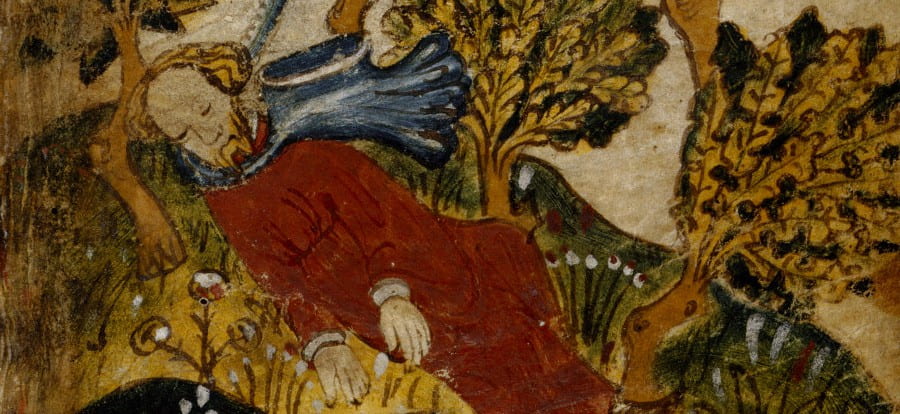| Category | Text (Part of The Lais of Marie de France) |
| Form | Poetry (Lai) |
| Genre | Romance |
| Author | Marie de France |
| Time | Late 12th Century |
| Language | Anglo-Norman French |
| Featured In | Literature and Humanities 1 (YCC1111); Medieval Romance: Magic and the Supernatural (YHU2309) |
The eighth lai in the collection, “Laüstic”, considers the tension between the need for secrecy in love affairs, the impossibility of privacy, and the act of revealing tokens of love to an outsider. It comes after the lai of “Yönec” and before “Milun”. It is also one of the shorter lais, consisting 160 lines.
SUMMARY

The lai begins like many others, with an extramarital affair, although the lovers in this case are neighbours. They communicated through their windows, tossing each other gifts and pleasing each other with words and speeches about love. One summer, the lady’s husband demanded to know her whereabouts as he does not see her often. The lady reveals that she has been enchanted by a nightingale and its song, angering her husband, who then captures the bird and kills it before her eyes. She sends the dead nightingale to her lover, who then makes a reliquary and keeps the bird within, from then on carrying it with him always.
DISCUSSION
The setting of the mansions is described to be “strong and fortified” (Marie de France 120), castle-like despite the fact that their inhabitants are only ranked as knights. Even with all the fortifications, and the obstacle of “a great high wall of dark-hued stone” (121), the lovers are somehow still able to see and communicate with each other in secret easily, as though there was no barrier between them at all, and that it seems as though they are able to do so simply because there is such a need. Nonetheless, the close proximity of the mansions is a double-edged sword that makes it easy for the lady’s husband to notice her absences and even easier for him to catch the nightingale, which is often a metaphor for spring awakening and love.
The nightingale can be seen as a kind of token of love that allows the lovers to recognise each other. However, in this case, the token of love is revealed to someone aside from the lover, namely the lady’s husband, who then became angered and sought to ruin it. One may infer that the husband’s interrogation is a form of test for the relationship between the lady and her lover, and one that the lady fails the moment she speaks of the nightingale. Her reveal of the token of love to an outsider essentially exposes her affair, which perhaps constitutes a betrayal towards her true lover. Therefore, no further tests on the relationship are introduced, nor does the relationship continue, and the lai ends shortly after.

One may question whether there was truly a specific nightingale which the lovers took as their token of love, given that it is only introduced when the lady is interrogated. In any case, the nightingale’s death suggests that the “birdsong”, which represents their loving meetings (122), has been abruptly cut short, and the death of the songbird corresponds to the death of their love. As a testament to this, the lady’s lover even places the dead bird within a “reliquary” (124)—a container for sacred relics—implying that their love is henceforth a thing of the past. Thus, the love symbolised by the nightingale, exposed and revealed when it is alive, is able to remain hidden away with the reliquary “sealed”. Yet Marie makes a final, somewhat playful remark on this story being spread to many people such that “it was no secret very long”, suggesting the action by the lady’s lover to be ultimately futile.
CREATIVE INTERPRETATIONS
In Memoriam, by MANISHA SAIGAL (’24).
The Lais by Marie de France is a collection of poems that explore different forms and boundaries of love and suffering. “Laüstic”, in particular, connects love and music in the form of birdsong; the song of a nightingale represents the connection between two distant lovers. I thus decided to reimagine “Laüstic” from The Lais as a 3-minute orchestral piece. I chose to write it as an orchestral piece to allow for more fluidity, conventional flexibility and elaborate nuances which enhance the emotion and imagery exhibited by the music. This piece is titled In Memoriam as it is written in memory of the life and death of the nightingale in the poem, and concomitantly, the love it represents.
Mal Mariée: Dance as a Medium for Resistance, by CLAIRE ZHAI HUAN TING (’24).
“Laüstic” is a poem that retells the experience of entrapment, encapsulated by the term Mal Mariée, a literary trope that appeared commonly in Medieval Romance. It refers to an unhappily married woman, under the constant surveillance and control of her husband. This piece of work seeks to pay tribute to the experiences of struggle of the female protagonist, and to explore dance as a medium for resistance, transposed to a modern setting. The definition of the body as a “complex, contradictory, and ever changing cultural site of ‘discursive intercourse’ which is constructed dialogically by the dancer and her audiences” (Reed, 519) equips movement with the tools to not only replicate experiences from the past, but also to inject new meaning into the endeavors and actions of characters. In this project, dance is examined as a channel for non-verbal communication, a physically situated activity that yields implicit meaning, and finally as a means for agency in the form of embodiment, therefore reflecting its capacity for resistance.
REFERENCES
Marie de France. Marie de France: Poetry. Translated by Dorothy Gilbert, W. W. Norton & Company, 2015.
IMAGE CREDITS
[Featured Image & Fig. 1] https://karligrazman.wordpress.com/author/karligrazman/
[Fig. 2] https://www.metmuseum.org/art/collection/search/464490
CONTRIBUTED BY TOH HONG JIN (’23), MANISHA SAIGAL (’24), & CLAIRE ZHAI HUAN TING (’24)




















